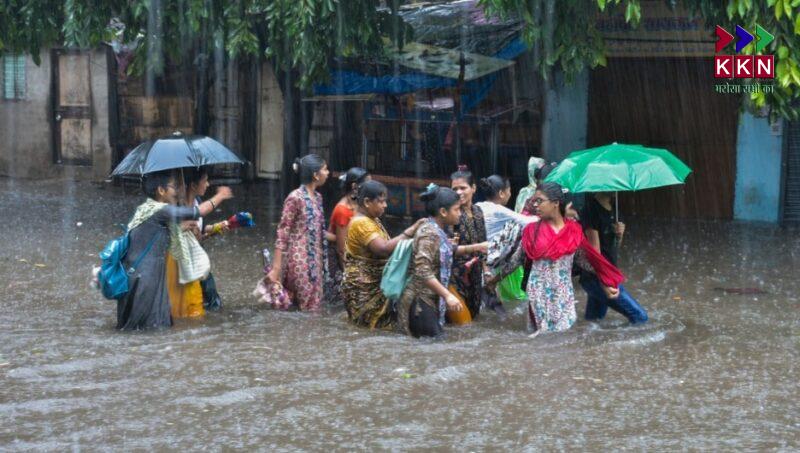
In a concerning weather development, heavy rainfall in Nepal has significantly raised the water levels of several rivers, including the Kosi and its tributaries, increasing the risk of flooding in northern Bihar. The situation has escalated across multiple districts, particularly Supaul and Madhubani, which are among the worst affected. The constant downpour in Nepal has sent alarm signals to local authorities in Bihar as rivers flow dangerously close to their danger levels. Many low-lying areas are already experiencing severe waterlogging, and the rising floodwaters have affected thousands of homes.
Yellow Alert Issued for Bihar, Weather Conditions to Worsen
As the heavy rainfall continues, the Meteorological Centre has issued a yellow alert for the state of Bihar, including 26 districts. The forecast warns of light to moderate rainfall, accompanied by the potential for lightning and gusty winds reaching speeds up to 40 km/h. The conditions are expected to intensify on Wednesday. Despite the alert, Bihar had not recorded any significant rainfall in the past 24 hours. However, the state’s concern lies in the rising water levels from neighboring Nepal’s rivers.
Bihar officials have urged the public, particularly farmers, to be cautious, especially in open areas during periods of lightning. The risk of flooding remains a major concern as the water levels in various rivers inch closer to the danger mark. The threat of floodwaters spilling over into nearby areas is real, and many districts are on high alert.
Supaul and Madhubani: Worst Affected by Rising Floodwaters
Supaul district, located in Bihar’s northern region, is one of the worst-hit by the rising waters. Six blocks in the district are reportedly inundated, with almost 5,000 homes being affected. The floodwaters have forced residents to flee their homes, seeking shelter on higher ground. These areas have experienced massive disruptions in daily life, with roads submerged and transportation routes cut off.
In Madhubani, another northern district, approximately 100,000 people are struggling due to the floodwaters. The rising rivers have inundated vast portions of the district, causing severe difficulties for residents. The situation in Madhubani has become dire, with water levels continuing to rise, and local authorities are struggling to provide adequate relief to those affected. Communities in low-lying areas are facing immediate risks as the floodwaters continue to encroach upon their homes and fields.
East Champaran and Other Districts at Risk from Sariswa River’s Rising Levels
Similarly, the situation in East Champaran has become critical. The rising water levels of the Sariswa River, originating from Nepal, have led to flood-like conditions in the areas of Raxaul, Ramgarhwa, Sugauli, Semra, and Motihari. These regions, particularly those situated in low-lying areas, are experiencing extensive waterlogging, which is causing disruptions in daily activities. The situation is expected to worsen if the rainfall in Nepal continues.
Local authorities have been working to monitor the water levels closely, and flood preparedness measures are being put in place. Efforts to clear drainage systems and create temporary embankments are underway, but with the constant threat of rising water levels, the risks to life and property remain high.
Patna Weather and Alerts for the Capital City
In Bihar’s state capital, Patna, the weather is expected to be cloudy throughout the day. The chances of light to moderate rainfall remain high, with the Meteorological Centre continuing its yellow alert for the city. As of now, the temperature in Patna has been recorded at 31.98°C, with an increase in humidity due to the ongoing weather conditions. These conditions are likely to persist, with occasional showers and winds expected to affect the daily routine.
Ongoing Challenges in Bihar Amid Heavy Rainfall
While Bihar has been accustomed to the annual monsoon rains, the situation this year is particularly alarming due to the added pressures from neighboring Nepal’s weather conditions. The combination of heavy rainfall in Nepal and the saturated ground in Bihar has contributed to the swift rise in river water levels. Authorities are working around the clock to ensure the safety of the people in flood-prone districts, but the escalating water levels present a significant challenge.
Efforts to evacuate people from vulnerable areas are in progress, with local government agencies providing relief supplies, including food, water, and temporary shelter. However, the sheer scale of the disaster has placed considerable strain on local resources. The ongoing rainfall continues to hamper relief work, with many areas cut off from the main routes due to flooding.
Urgent Measures and Government Response to the Flood Situation
The state government, along with disaster management teams, has stepped up efforts to provide relief to the affected districts. Emergency response teams have been deployed to assist in the evacuation and rescue of stranded residents. Health and sanitation teams are also on high alert to prevent any outbreaks of waterborne diseases in the flood-affected areas.
In addition, Bihar’s government has announced emergency relief funds to assist the affected districts, providing financial aid to support the rehabilitation of those displaced by the floods. Temporary shelters are being set up in schools and community centers to accommodate evacuees.
Key Takeaways from the Current Flood Situation in Bihar and Nepal
The ongoing floods in Bihar, fueled by heavy rainfall in Nepal, highlight the vulnerability of low-lying areas to rising river levels. The situation is especially concerning in districts like Supaul, Madhubani, and East Champaran, where the impact of floodwaters is being felt across large swaths of land. The rising river levels of the Kosi and Sariswa rivers have brought life to a standstill in several areas, and authorities are working hard to prevent further damage.
With the weather forecast predicting continued rainfall, the situation remains fluid, and the risk of further flooding is imminent. As Bihar continues to grapple with this weather crisis, officials are urging the public to stay informed and take necessary precautions, especially during lightning and heavy rain conditions.
As the water levels in rivers like the Kosi and Sariswa continue to rise, residents of northern Bihar must remain vigilant. The combination of heavy rainfall and rapidly rising rivers poses a significant flood risk, with several districts already experiencing severe impacts. The government’s response, including the issuing of alerts, the provision of emergency aid, and evacuation efforts, is crucial to minimizing the damage caused by these floods. The situation remains under close observation, with further updates expected as the rainfall pattern in Nepal continues to influence the water levels in Bihar’s rivers.
With the coming days expected to bring more rainfall, authorities are on high alert to manage the situation and ensure the safety of the residents in flood-prone areas.


